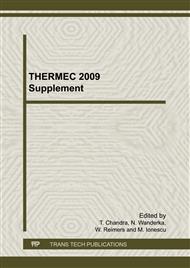p.353
p.359
p.365
p.371
p.377
p.383
p.389
p.395
p.400
Changes in Microstructure of Biomedical Co-Cr-Mo-C Alloys with Solution Treating and Aging
Abstract:
Microstructural changes occurring in biomedical Co-Cr-Mo alloys with three carbon levels due to solution treatment and aging were investigated. Ingots of Co-Cr-Mo alloys with three different carbon levels were prepared by vacuum furnace melting; their chemical composition was Co-28Cr-6Mo-xC (x = 0.12, 0.25 and 0.35 mass%). Precipitates were electrolytically extracted from as-cast and heat-treated alloys. An M23C6 type carbide and a phase were detected as precipitates in as-cast Co-28Cr-6Mo-0.12C alloy, and an M23C6 type carbide and an phase (M6C-M12C type carbide) were detected in as-cast Co-28Cr-6Mo-0.25C and Co-28Cr-6Mo-0.35C alloys. Only the M23C6 type carbide was detected during solution treatment. Complete precipitate dissolution occurred in all the three alloys after solution treatment. The holding time required for complete precipitate dissolution increased with increasing carbon content and decreasing solution treatment temperature. Complete precipitate dissolution occurred in the Co-Cr-Mo-C alloys solution treated at 1523 K for 43.2 ks; they were then subjected to aging from 873 to 1473 K for a heating time up to 44.1 ks after complete precipitate dissolution in solution treatment at 1523 K for 43.2 ks. The M23C6 type carbide with a grain size of 0.1–3 m was observed after aging. A time-temperature-precipitation diagram of the M23C6 type carbide formed in the Co-28Cr-6Mo-0.25C alloy was plotted.
Info:
Periodical:
Pages:
377-382
Citation:
Online since:
January 2010
Authors:
Keywords:
Price:
Сopyright:
© 2010 Trans Tech Publications Ltd. All Rights Reserved
Share:
Citation:


